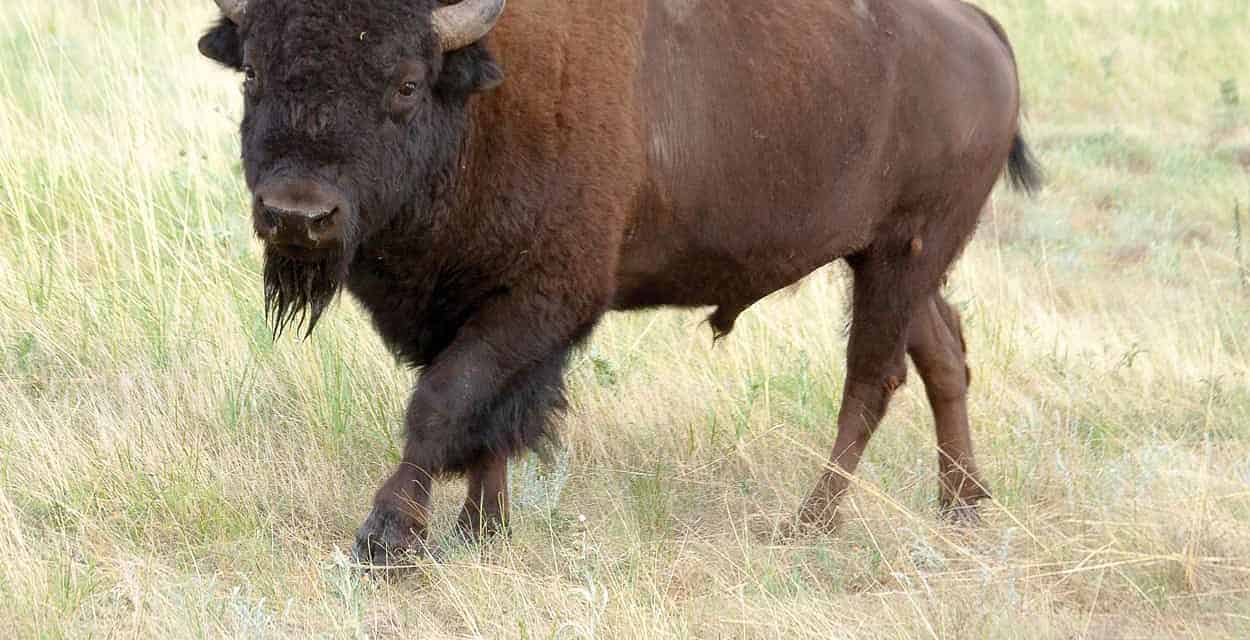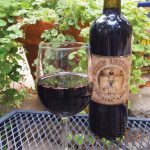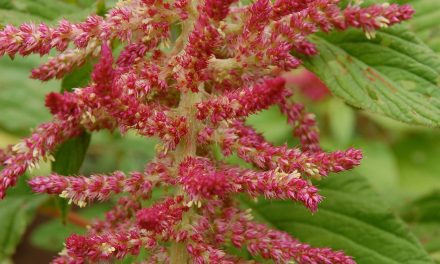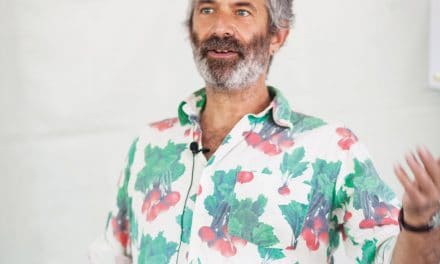Ted Turner takes care of business
(and bats and bison) on his New Mexico ranches
By Candolin Cook · Photos by Stephanie Cameron

“I love that you are tailgating at the bat cave!” laughs microbat biologist Laura Kloepper while making her way across a field of lava rocks toward our dinner spread. “We don’t go anywhere without food,” shouts back edible publisher Stephanie Cameron. It is an early summer evening on the sprawling Armendaris Ranch, situated along the Rio Grande and Fra Cristobal mountain range in central New Mexico. Kloepper, a professor at St. Mary’s College in Indiana, has spent the last month studying bat bioacoustics here at the ranch’s Jornada Bat Caves, a system of collapsed lava tubes where, each night from June to September, one million Mexican free-tailed bats emerge to forage insects until dawn. The Armendaris is one of sixteen ranches (totaling 2.1 million acres) scattered across the greater American West belonging to billionaire businessman, humanitarian, environmentalist, and part-time New Mexican, Ted Turner.
In the nineties, Turner purchased three ranches in New Mexico after seeing their potential for private and commercial use, as well as for sites of ecological conservation and scientific study. The Armendaris and its companion ranch, the Ladder, flank the small town of Truth or Consequences, and together make up more than half-a-million acres of high-desert grasslands, mountains, canyons, wooded river beds, and working ranchland. Beginning in 2015, the self-described eco-capitalist opened the Armendaris and Ladder properties to the public through his eco-tourism outfit, Ted Turner Expeditions (TTX). Private tour options include sightseeing, hiking, biking, mountain climbing, hot air ballooning, and the Jornada Bat Cave flight. As TTX activities manager David Barfield explains, “It’s like having a national park all to yourself.”

Top: Bat flight at Armendaris Ranch. Bottom, left: Laura Kloepper with her “biological drone.” Bottom, right: Chiricahua leopard frogs’ breeding tanks.
From our hotel room at Turner’s Sierra Grande Lodge & Spa in T or C, it takes an hour of four-wheel driving across rugged dirt roads to reach the remote cave. For another two hours, we wait, snack, and nervously survey the lava rocks for rattlesnakes. Then it happens. The smell of ammonia fills our nostrils as millions of tiny wings begin to kick up guano dust inside the cavern. As the bats begin to swirl furiously at the mouth of the cave, Kloepper yells to her colleague Paul Domski: “It’s time!” Reaching into a covered box, Domski pulls out Banshee, a magnificent Harris hawk wearing a custom go-pro and microphone. The falconer and Kloepper position themselves on opposite sides of the canyon leading to the cave. Suddenly the bats break from their eerie vortex and take to the sky. Kloepper raises a leather-gloved hand and the hawk sails toward her, swooping through the torrent of bats, recording their sights and sounds. For twenty solid minutes, Cameron and I stand in awe as the bats emerge from the cave, creating a black river that stretches for miles across the twilit sky.
Kloepper hopes the decibel readings her “biological drone” records will help her team refine techniques to gauge bat colony populations and, eventually, help fight bat epidemics like white-nose syndrome. But her work, made possible by Turner through special access to the caves, is just one of dozens of ongoing ecology-minded projects taking place on Turner’s ranches. With a mission statement to “save everything,” the Turner Endangered Species Fund (TESF) works with the US Fish and Wildlife Service and New Mexico Game and Fish Department to restore natural habitats and increase populations of endangered and threatened animals. At the Ladder and the Armendaris, these animals include the Bolson tortoise, Chupadera springsnail, Rio Grande cutthroat trout, Chiricahua leopard frog, and Mexican wolf, among others. Cassidi Cobos, a TESF biologist who breeds Chiricahua leopard frogs at the Ladder Ranch, says that the habitats she and her colleagues maintain are critical to the survival of this threatened species of frog, which faces challenges from drought, invasive species, disease, and environmental degradation. TTX guests are welcome to view the Chiricahua leopard frogs’ breeding tanks and stock water habitats from specially-built viewing platforms so not to disturb the frogs. Cobos says, “I live here, so sometimes I forget how unique it is, but it really is amazing for guests to witness these animals and see them thriving.” As Turner recently told a journalist, “TTX is a way for guests to . . . enjoy the lands, while knowing the money they’ve spent is going back into our environmental projects.”
Not that Turner is against personally profiting from his lands. For instance, his 585,000-acre Vermejo Park Ranch near Raton generates income through exclusive lodging accommodations, hunting, fishing, bison ranching, solar energy, “responsible” forestry, and leases from heavily-regulated natural gas drilling. While environmentalists may criticize some of these practices, others might argue that in a time of the US government pulling its support from the Paris Agreement, making deep cuts to the Environmental Protection Agency, and introducing bills to roll back the Endangered Species Act, eco-conscious allies in the business world are imperative, even if imperfect. Turner writes in the forward to his biography Last Stand: Ted Turner’s Quest to Save a Troubled Planet, “On my lands, I have set out to prove that the polemic of environment versus economy is a false dichotomy, that you can be a tree hugger and still have your name appear in Forbes.. . .We need a new model for thinking about capitalism and our obligation as global citizens.”

Where the Buffalo Roam
Perhaps nothing embodies Turner’s convergence of conservation, capitalism, and a romanticized American West as aptly as his bison herds. According to his biography, Turner’s fascination with bison started as a child watching westerns. “The cavalry or cowboys would be killing off Indians. What was it they did wrong? They were the victims, and I sympathized. Then I realized . . . that the same kind of thing happened to the bison.” Turner says he vowed to try and raise some bison if he “ever got some money.”
By the end of the nineteenth century, the United States’ once mighty bison population of thirty million had been hunted to the brink of extinction—largely for their hides, but also as part of an effort by the US government to pacify Native tribes whose diet relied heavily on the animal. When Turner purchased his first three bison in 1976, the population had rebounded modestly to thirty thousand. Since entering the bison ranching industry in 1989, Turner, along with other ranchers, conservationists, federal programs, and the InterTribal Bison Cooperative, has increased the population to 500,000, according to the National Bison Association (NBA). With fifty-three thousand head, Turner is the largest private bison rancher in the world. There are eighteen hundred at the Armendaris and two thousand at Vermejo alone, including the extremely rare, genetically “pure” (free of cattle mtDNA) Castle Rock Herd—descendants from turn-of-the-century Yellowstone National Park bison.
A major reason Turner’s western landholdings are so large is that bison require vast grasslands. As bison graze, they fertilize the land; create beneficial habitats for prairie dogs and other wildlife; and create less trampling, erosion, and water damage than cattle. But bison ranching is not without its controversies. Ninety percent of bison are raised for meat production and sold to retailers, such as Turner’s bison-focused restaurant chain, Ted’s Montana Grill. Raising bison for slaughter can make uneasy bedfellows of ranchers and preservationists. But true to his eco-capitalist brand, Turner believes that the most effective way to save the species is by marketing it. According to NBA Executive Director Dave Carter, “Bison represents the greatest success story in market-based restoration. The public’s growing love of bison meat is providing the incentive for us to build the herds.”
Another controversial aspect of commercial production is that the majority of bison, even those grassfed like Turner’s, are finished with grain. While the health benefits of eating lean bison meat are a selling point for many consumers, Americans generally prefer proteins with a certain ratio of fat and a consistency of taste. To achieve that, ranchers will herd their bison into feedlots in the last three to six months before slaughter and introduce a diet of corn, oats, and hay. Feedlot practices have notoriously contributed to a host of environmental and public health problems, from pesticide use and monocropping to water contamination and disease outbreak. However, bison do spend less time in feedlots than grain-fed or finished cattle and, unlike beef, federal regulations prohibit antibiotic and growth hormone injections. “We recognize that our customers have high expectations on how we raise the animals and manage our herds,” says Carter. “Even as we expand production, we are working to make sure that we never turn bison into another ‘commodity’ product. We recognize that Mother Nature did a great job in perfecting this animal through thousands of years, so why do we want to mess that up?”

Last year, US bison meat sales reached $350 million. This past July, Turner’s Flying D ranch in Bozeman, Montana, hosted the NBA’s largest-ever convergence of bison ranchers, where they rolled out their Bison 1 Million initiative. Through a collaboration with commercial ranchers, conservation herd managers, and tribal producers, the initiative seeks to raise the North American bison population to one million over the next ten to fifteen years. Carter says while this goal is ambitious, it is important for several reasons: to keep up with consumer demand; to help restore economic and cultural health on tribal lands; to offer a viable entry point for young and beginning ranchers; and to provide a more environmentally sustainable ranching alternative to cattle production. “Restoration is about much more than producing more bison meat,” he says. “More than thirty percent of the North American ecosystem is a native grassland environment. Those grasslands—which play a vital role in capturing carbon from the atmosphere and sequestering it in the soil—evolved through thousands of years of grazing by bison and other ruminants. Properly managed bison herds stimulate healthy grasslands and help build healthy soil. Bison are the perfect animals for regenerative agriculture.”
To achieve their goal, the NBA is working with public and private entities to expand herds and open doors for new producers. They are also launching a media campaign branding Wednesdays “Bison Hump Day,” in the vein of Meatless Mondays or Taco Tuesdays. And, as they have for the last thirty years, the bison community is relying on Turner for support. “Ted has been a great asset to the bison business, and to the conservation of the species. Through the years, Ted has hired excellent people to run his ranches and manage his herds. And, he has encouraged those people to share their knowledge and experience with everyone else in the business. The mission statement for Ted’s ranches is to be both economically and environmentally sustainable. He and his people are continually exploring ways to make that happen and mentoring others,” says Carter.
Unsurprisingly, visitors won’t see a single cow on a TTX tour. The day after our bat adventure, Barfield takes Cameron and me riding around the Ladder in a UTV. Within a few hours, we spot prairie dogs, burrowing owls, pronghorn, quail, Chiricahua leopard frogs, oryx, elk, and bison. “The biodiversity is what really sold Turner on the Ladder,” explains Barfield. “It’s as close as you’re going to get to an African safari in the United States,” says Turner Enterprises communications manager Baldwin H. Chambless. Notably, we don’t encounter another tourist. “We want to keep it pristine for the animals and special for the guests,” says Barfield. As we start to head back, creosote bushes and an impending monsoon fill the air with the scent of summer rain. A Swainson’s hawk clutching a rattlesnake in its talons flies overhead. Like the man himself, Turner’s ranches are both inspiring and complicated, but you will leave wanting to save everything.
MAKE A DIFFERENCE:
- Support the return of bison to Native land, diets, and economies by donating to the Tanka Fund: www.tankafund.org
- To support efforts to build soil, biodiversity, and resilience on western working landscapes, donate to the Quivira Coalition: www.quiviracoalition.org
- Visit the Turner Endangered Species Fund website to learn more about the organization’s conservation work in New Mexico: www.tesf.org
- To book eco-tours through Ted Turner Expeditions, visit: www.tedturnerexpeditions.com
Candolin Cook is a historian, writer, editor, and former co-editor of edible New Mexico. She recently received her doctorate in history from the University of New Mexico and is working on her first book.













